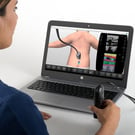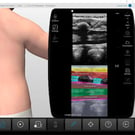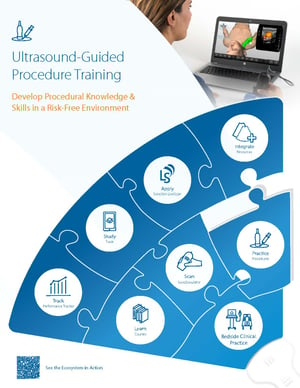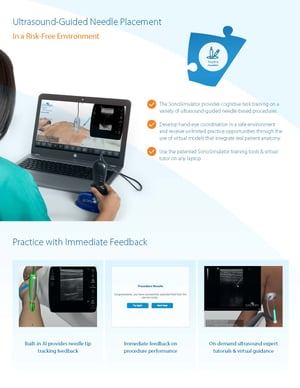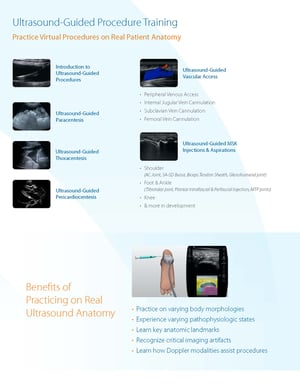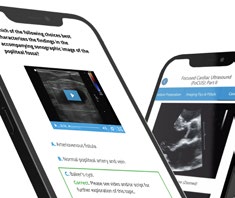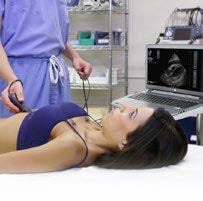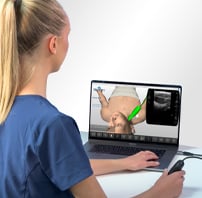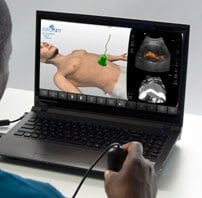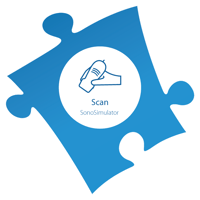Ultrasound-Guided Procedures
Learn to Perform Ultrasound Procedures involving Needle Guidance
Using real-time ultrasound guidance for a multitude of procedures, such as peripheral IV access, is becoming the “standard of care”. However, performing these challenging procedures requires significant ultrasound procedure knowledge and psychomotor skills.
SonoSim provides a safe and convenient setting for learners to practice a variety of ultrasound-guided procedures. This unrestricted access to deliberate practice is an essential element for acquiring the ultrasound procedure knowledge, psychomotor skill, and confidence required for success with ultrasound procedures.

Ultrasound-Guided Procedures: Train in a Risk-Free Environment
Develop ultrasound procedure knowledge and psychomotor skills with SonoSim ultrasound-guided procedure training. SonoSim develops ultrasound procedure knowledge using real patient data sets that vary in body morphology, right versus left-sided approaches, and pathophysiologic states. Learners benefit from SonoSim probe guidance, virtual tutoring, real-time performance feedback, and learning to use advanced Doppler applications during ultrasound procedure survey scans. SonoSim is designed to overcome traditional barriers to ultrasound education, allowing learners to access our resources anytime and anywhere using their PCs.
Optimize Ultrasound-Guided Procedure Success
Improve Your Needle Tip Tracking & Guidance During Ultrasound Procedures
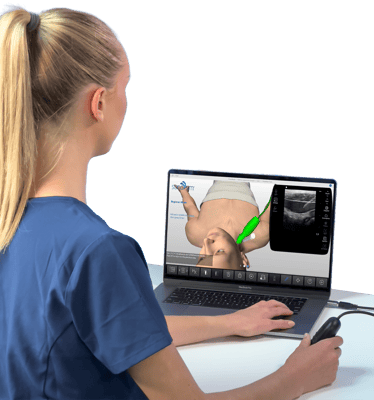
- Train Using Real Patient Anatomy - Learning to recognize sonographic anatomy and key landmarks on real anatomy has significant benefits over alternative approaches (e.g. tissue phantoms, CGI)
- Pathophysiological Variation - Executing ultrasound procedures on target structures that vary (e.g. collapsed internal jugular) matches real-life conditions
- Anatomic Variation - Access to varying body morphologies and right/left side anatomy ensures procedure execution flexibility
- Virtual Tutor & Procedure Guide - Access on-screen tutors and guides to coach you through ultrasound procedures
- Real-time Performance Feedback - Validated expert system-based AI provides real-time procedure feedback on each attempt
- Unlimited Deliberate Practice - Unlimited practice performing ultrasound procedures in a safe, controlled setting
- Breadth of Procedures - A broad & expanding list of ultrasound-guided procedures to choose from
- Flexible, Remote Training - On-demand access to ultrasound-guided procedure training on any laptop, for learners of all levels, from beginner to advanced
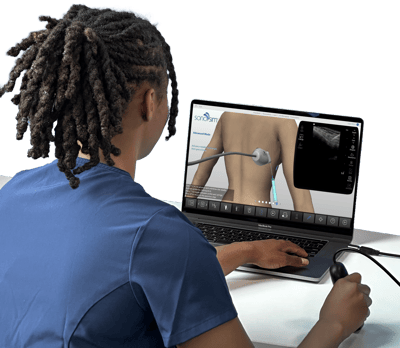
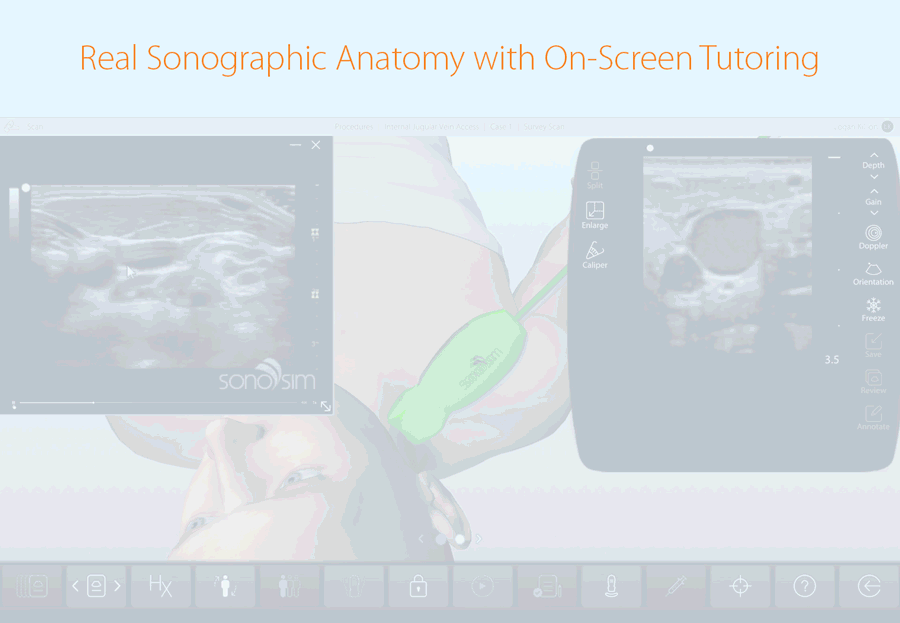
Ultrasound-Guided Cognitive Task Training
Unlimited Practice - Acquire Critical Ultrasound Procedural Skills

Advanced Ultrasound-Guided Procedure Training
Practice Virtual Ultrasound Procedures on Real Patient Anatomy
Perfect Your Ultrasound IV Training Skills & More
in a Safe Virtual Environment
SonoSim provides comprehensive cognitive task training for a variety of ultrasound-guided procedures, including ultrasound for IVs. Learners get real-time feedback following each ultrasound procedure attempt provided by SonoSim’s validated expert system-based AI technology. They also have the ability to use a variety of relevant Doppler modalities. This foundation of procedural knowledge and skill can further be refined using real ultrasound machines and phantoms in more formal settings such as a simulation center. Think of SonoSim as providing the critical pre-training that helps learners get the most out of their limited opportunities using tissue phantoms and real ultrasound machines for ultrasound procedure training.
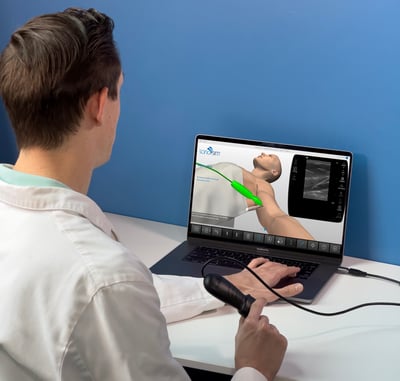
FAQ
What ultrasound-guided procedure training do you offer?
Our library of ultrasound procedures is constantly growing via feedback from our clients. We today provide a variety of needle-based procedures, such as ultrasound IV procedures, as well as complex procedures like renal transplants. See a full list.
Do you offer in-person training?
SonoSim is a self-paced, virtual learning platform for ultrasound, geared to help you incorporate ultrasound learning in the easiest way possible. At this time, we do not offer in-person classes.
What other types of ultrasound training do you offer?
We offer 85+ peer-reviewed ultrasound training topics, ranging across subspecialties and topics. SonoSim provides the industry’s most comprehensive ultrasound training platform, and we are still growing.
Get a full list of all our available topics.
SonoSim Ultrasound-Guided Procedures - Get the Practice Brochure!
Unlimited Ultrasound Procedure Practice in a Virtual, Safe Environment
The SonoSim Ecosystem
Comprehensive Ultrasound Learning & Teaching
Flexible Learning Pathways
A Customizable Ecosystem for Every Program
85+ Ultrasound Courses across a variety of Ultrasound topics and learning levels
Innovative ultrasound simulation environment. Master scanning skills with the SonoSimulator. Accessible anytime, anywhere.
A growing library of Challenge Cases enables learners to continually scan new pathologies & acquire new skills.
Explore the SonoSim Ecosystem
Next Element - Track
The SonoSim ecosystem is made up of 7 separate, yet complementary elements. Learn how each one plays a crucial role in helping you solve the ultrasound competency puzzle.
The SonoSim Wave
An Ultrasound Insights Newsletter
Get the latest trends in ultrasound training, education, & applications delivered to your inbox.


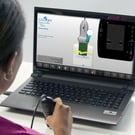
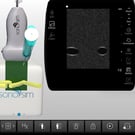
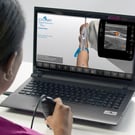
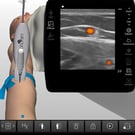
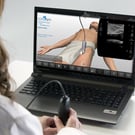
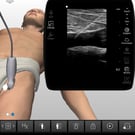
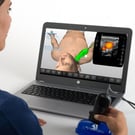
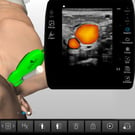
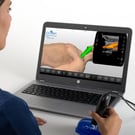
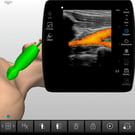


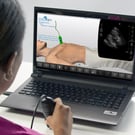
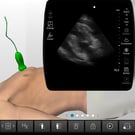
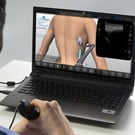
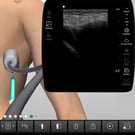
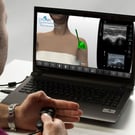
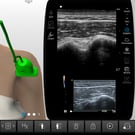
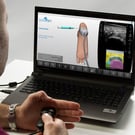
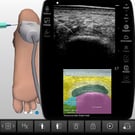

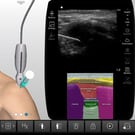
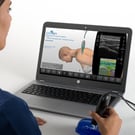

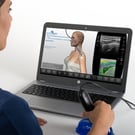
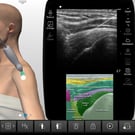
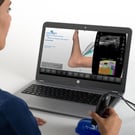
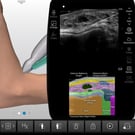
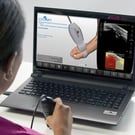
.jpg?width=135&height=135&name=procedure_methatarsophalangeal_case_screen__08737%20(1).jpg)
